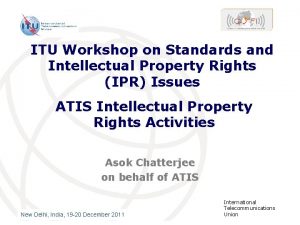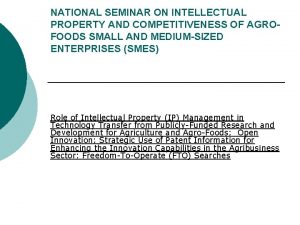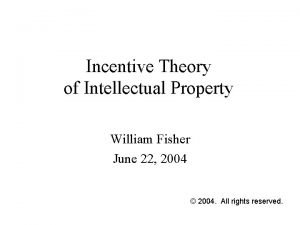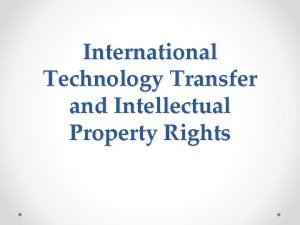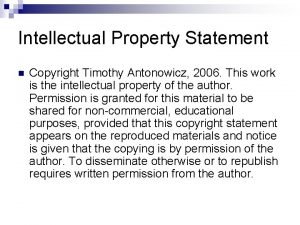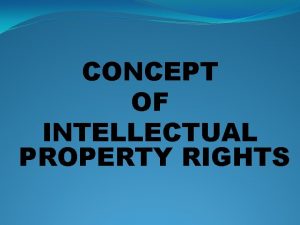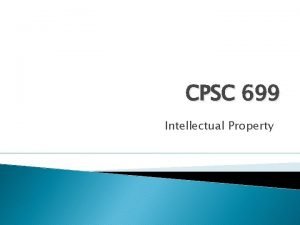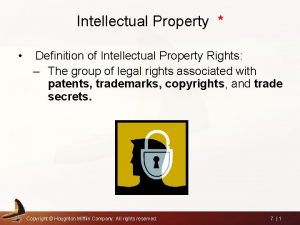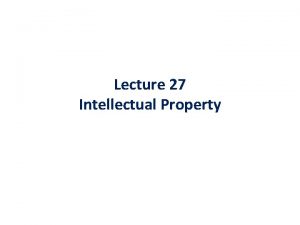Intellectual Property What is intellectual property Intellectual property













- Slides: 13


Intellectual Property What is intellectual property? � Intellectual property (IP) is an intangible thing such as an idea or innovation that, in most parts of the world, you can own, similar to the way that you can own tangible things like a car or a land. 2

intangible thing � The intangible thing can be something that you have : 1) written, 2) drawn, 3) designed, 4) Invented, or 5) spoken, and it can be something that you have created yourself or paid someone to create for you. 3

Intellectual property rights (IPRs) � IPRs emerged in the industrialized world as a means to mediate and control the circulation of knowledge, and as a means of balancing the conflicting rights of different groups involved in the generation and use of ideas of economic value. � IPRs are premised on concerns that the creators or authors of ideas should have a material right to a fair return for their effort and a moral right not to have their ideas misrepresented. 4

Cont… � ideas are not simply the product of individuals and corporations. � Society in general has a social right to use ideas for the benefit of the public good – especially if they are key to social and physical well being. 5

Rules for IP protection � The rules for IP protection, such as the scope of protection and the requirements for obtaining protection, are set out and enforced in laws and regulations of national governments. 6

What are the four distinct types of protection given to intangible property? 1) 2) 3) 4) Patents ( )ﺑﺮﺃﻪ ﺍﻷﺨﺘﺮﺍﻉ Trademarks ( )ﺍﻟﻌﻼﻣﺎﺕ ﺍﻟﺘﺠﺎﺭﻳﺔ Copyright, ( )ﺣﻘﻮﻕ ﺍﻟﻄﺒﻊ Trade secrets. ( )ﺍﻷﺴﺮﺍﺭ ﺍﻟﺘﺠﺎﺭﻳﺔ 7

International institutions that play a role in IP protection � There a number of international treaties and agreements that aim to harmonise national IP laws across countries: 1) The World Intellectual Property Organisation (WIPO) 2) Trade-Related Aspects of Intellectual Property Rights (TRIPS). 3) World Trade Organisation (WTO). 8

Brief History of WIPO • Paris Union 1883 • Berne Union 1886 • International Bureau combined 1893 • WIPO Convention 1967 • UN Specialized Agency 1974 • 184 Member States (as of end of October 2010) 9

Basic Facts about WIPO’s Mission: To promote the protection of IP rights worldwide and extend the benefits of the international IP system to all member States Status: An int’l intergovernmental organization Member States: 184 Observers: 250 + Staff: 950 from 101 countries Treaties Administered: 24 Decisions by: GA, CC, WIPO Conference 10

WIPO � Effort to demystify IPR and make it more accessible and relevant to a broader group of people � IP no longer to be seen from solely a legal perspective but also its place in the society as a tool for economic growth � A means to an end, and not an end in itself. 11

WIPO’s Mandate � WIPO is dedicated to developing a balanced and accessible international intellectual property (IP) system, which rewards creativity, stimulates innovation and contributes to economic development while safeguarding the public interest. 12

Obstacles � Obstacles meet the IP system are: - 1) Limited awareness of the IP system and its relevance as a strategic tool 2) High costs (filing, translation, drafting, maintain) 3) Complexity of IP system 4) Delays in obtaining IP rights 5) Lack of expertise to make use of the IP system 6) Success rate in getting IP rights (patents) low 7) Inability to monitor and enforce 13
 Intellectual property rights
Intellectual property rights Intellectual property business plan
Intellectual property business plan Intellectual property
Intellectual property Incentive theory
Incentive theory Discuss intellectual property frankly
Discuss intellectual property frankly Importance of intellectual property
Importance of intellectual property Intellectual property rights
Intellectual property rights Property
Property Intellectual property statement
Intellectual property statement Concept of intellectual property
Concept of intellectual property At&t ecommerce
At&t ecommerce Intellectual property management definition
Intellectual property management definition Discuss intellectual property frankly
Discuss intellectual property frankly Characteristics of intellectual property
Characteristics of intellectual property
